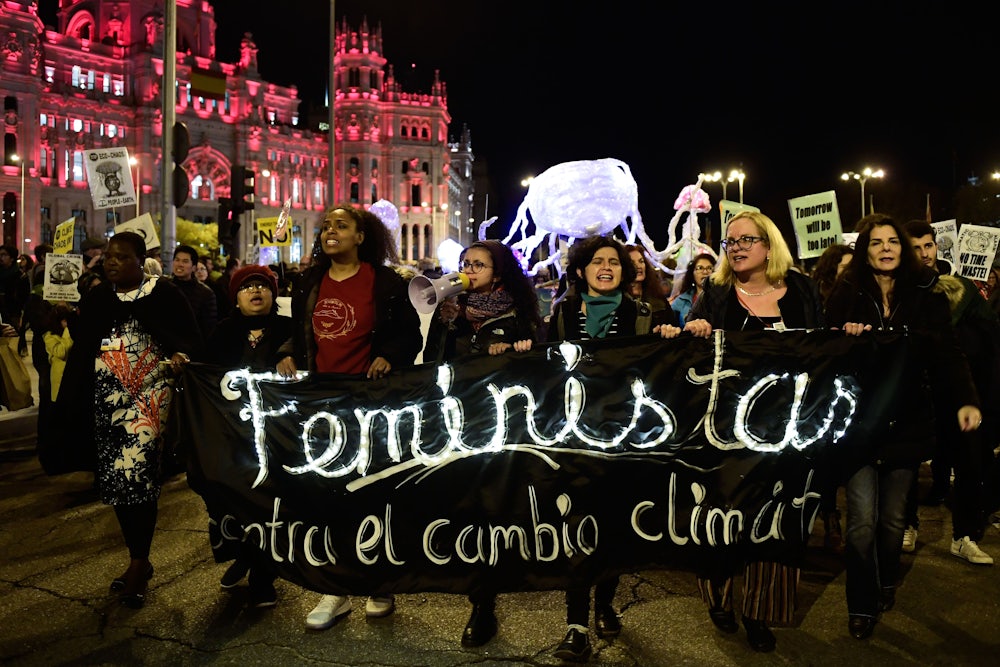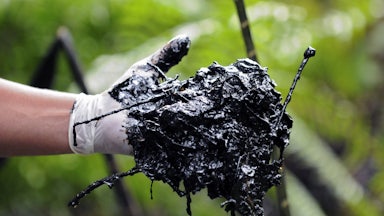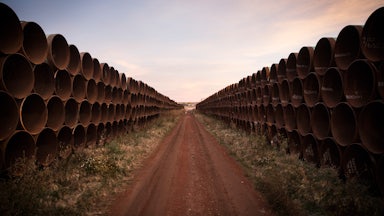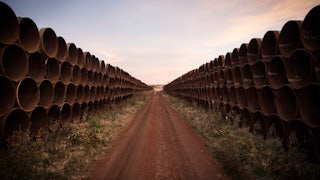Feminism or death? That’s the choice the French writer Françoise d’Eaubonne, who coined the term ecofeminism, offered readers in her 1974 groundbreaking treatise, Le Féminisme ou la Mort. Gendered violence and the degradation of the planet are both “the price of phallocracy,” she declared. The solution, d’Eaubonne wrote, was to overthrow not simply patriarchal power but the concept of power itself: “The planet placed in the feminine will flourish for all.”
Fifty years later, the first English edition of this work—subtitled “How the Women’s Movement Can Save the Planet”—arrives at a strange moment. Ecofeminism has perhaps never been more passé in the West, the term weighed down by previous incarnations of ecofeminist activism that centered whiteness, promoted essentializing views of the body, and advanced a reductive and appropriation-minded mysticism. Yet addressing the complex linkages between marginalized identities and the environment has never been more urgent, as climate change (an anthropogenic assault on the planet), the Covid-19 pandemic (likely the result of a tattered human-wildlife interface), and even the Russian invasion of Ukraine (a fossil fuel–infused nightmare) have so clearly illustrated.
Ecofeminism could help us to challenge the broken logic of war, pollution, and extraction, argue Myriam Bahaffou and Julie Gorecki in their new introduction to d’Eaubonne’s text. While d’Eaubonne failed to grapple with the racism and imperialism of her own era, her ecofeminist lens helps today’s readers draw “a clear connection between the treatment of the bodies of women, the enslaved, the disabled, and the racialized, and the treatment of lands, animals, and plants” they write, all of which are subject to exploitation as “naturalized terrains of experimentation or conquest.”
In a new incarnation, sensitive to difference, ecofeminism could help us to recognize meaningful linkages in violence against both human and nonhuman life, writes Norie Ross Singer, a communications professor at Saginaw Valley State University. It could also lead to solutions in the form of restorative justice, nonviolence, and an emphasis on care. “The ecofeminist ethic has contributed to a critically compassionate world: a praxis of reaching out, but without naivety,” Singer writes.
But to be useful today, ecofeminism must continue to radically reorient itself: The failures of imagination among d’Eaubonne and her generation of white Western ecofeminists have often obscured the fact that some of the most potent expressions of feminist activism for environmental justice are coming from far outside the West.
In the United States, ecofeminism has been sidelined for decades. It’s “either not taught at all or it’s lumped with the second wave—[as if] ‘oh that’s behind us,’” Singer told me. But if one takes the global view, ecological and environmental questions have been central to the feminist project from its inception in the nineteenth century and remain so today. That’s why Singer prefers ecofeminisms, in the plural—there’s never been, and never will be, just one.
The problem with American ecofeminism emerged in the 1970s, as activists and writers built an ecofeminist social movement that was anti–nuclear weapons, infused with hippie or New Age counterculture values, and fundamentally informed by a white, middle-class environmentalism, says Kishi Ducre, associate dean for diversity, equity, and inclusion at Syracuse University and an environmental sociologist. Many white ecofeminists aligned with the “Goddess movement,” a polarizing neopagan faith popularized by The Spiral Dance, by ecofeminist writer Starhawk (née Miriam Simos), which described an egalitarian, harmonious society based on “[witch]craft” that supposedly once spread around the world. Many American ecofeminists also shared the exclusionary conviction that either a biological status or socialized oppression gave cisgender women a special perspective on the environment.
Crucially, ecofeminists of this era often took their values to be universal, says Chelsea Mikael Frazier, a faculty fellow at Cornell University who has articulated a separate framework called Black feminist ecological thought. The result was that white Western ecofeminist scholarship often neglected other feminisms and environmentalisms that decentered whiteness and placed the concerns of Black Americans or non-Western women at the center. As an overwhelmingly white group of ecofeminists gathered on the Pentagon lawn for an anti-arms protest in 1980, Black activists in North Carolina were gaining traction in their protests against toxic waste dumped in their farming communities—an act that civil rights activist Benjamin Chavis would label “environmental racism” in 1982. Yet white American ecofeminism of this period largely failed to develop an intersectional practice and ended up neglecting some of the clearest examples of feminist environmentalism’s true potential.
Ecofeminist principles have been crucial in
many times and places, including contemporary South Asian politics. The Chipko movement, for example, emerged in the early 1970s in India’s Himalayan region of Uttarakhand, where widespread deforestation had led to
severe flooding, washing away homes, killing locals, and depleting resources
available to those still living in the region. A
group of largely female villagers organized a number of nonviolent
confrontations with lumber company employees, involving drums, song (“What do the forests bear? Soil, water, and pure air”),
and the physical protection of trees (chipko, which means “hug,” is the inspiration for the English-language
concept of “tree-huggers”). While this work predated the coining
of the term ecofeminism, in affirming inherent value in the lives of women,
the poor, and the forest and challenging the male-dominated, corporatist view
of the region’s abundant life as inert resources, Chipko activists articulated
ideals that are now considered central to the the global ecofeminist effort.
Today, South Asia remains a stronghold of ecofeminism. One of the most famous self-identified ecofeminists in the world is Vandana Shiva, a Chipko volunteer, a controversial leader in India’s anti-GMO movement, and an advocate of responsible agriculture more generally. Like her Western counterparts, Shiva has been criticized for espousing essentialist views, but she has also helped to establish seed banks in India, promote biodiversity conservation, and challenge the “dead Earth” perspective that treats nature and human culture as separate, the planet as an exploitable entity, and modern science as the means of control. In 2014, Shiva told an audience she saw two trends in the world: “One: a trend of diversity, democracy, freedom, joy, culture—people celebrating their lives,” she said. “And the other: monocultures, deadness. Everyone depressed. Everyone on Prozac. More and more young people unemployed. We don’t want that world of death.”
Ecofeminism also remains potent in Latin America, particularly among Indigenous women fighting to protect the Amazon. In Ecuador, for example, Indigenous women have put themselves in between developers and the forests, fending off drilling, mining, and logging even in the face of abuse at home and in public. They’ve also drawn connections between the work of resource extraction and gendered violence, not just theoretically but at work in the real world. “When these extraction projects come onto their [Indigenous] territory, it’s completely devastating to their way of life—their waterways, their environment, their culture,” Leila Salazar-López, executive director of the conservation nonprofit Amazon Watch, told this magazine in 2018. “But these oil companies and security forces also bring sexual and domestic violence.”
In the U.S., ecofeminism may seem over and done with. But by pushing ecofeminism to become “more inclusive of indigenous women’s perspectives,” Indigenous activists have “transformed” the field, according to social scientist Andrea Sempértegui. And, she argues, allyships between activists and ecofeminists around the world can continue to grow and deepen, even as their differences in perspective, approach, and experience remain. In light of the climate crisis and the urgent need for international solidarity in addressing it (rich global north countries so far have failed to deliver on their commitments of aid to the vulnerable, poorer, oft-exploited countries least responsible for the crisis), ecofeminist perspectives could provide another helpful framework for action—one that highlights the role of patriarchal oppression and gendered violence in a way anti-capitalist and anti-imperialist perspectives may not illuminate on their own.
While the lessons of ecofeminism, it’s clear now, are not universally applicable, there are many to choose from. The feminist ethics of care—which repositions vulnerability and interdependence, traditionally maligned as “feminine” qualities, as virtues—can be understood as an alternative to the dichotomy between production and consumption. In elevating the work of maintenance, care for existing life becomes a viable alternative to the endless growth mindset of capitalism. The same potential exists in efforts to center nonhuman beings, including plants and animals. When governments acknowledge the rights of nature, “dead Earth” mindsets can be forcibly curtailed, because the interests of the forest or the river are granted legal representation too. And in challenging the colonialist logic of land “ownership,” ecofeminists help to make room for other models, like stewardship.
In d’Eaubonne’s proposed contest between feminism and death, death now seems to be winning out. Between 1970 and 2016, the World Wildlife Foundation estimates the planet lost about 68 percent of its vertebrate species—an epic biodiversity loss resulting from land-clearing for agricultural use, global warming, and other anthropogenic causes. The World Health Organization estimates that about seven million people globally die prematurely from air pollution already. And fossil fuel production and consumption continue to rise, bringing heat deaths, natural disasters, and more death in their wake.
While feminists have periodically worried over their own discipline’s tensile strength—that the center cannot hold if the field moves beyond its central focus on the liberation of women—it’s undeniable the health of the planet is a feminist issue too. As feminism continues to widen its aperture, it doesn’t merely identify more problems to tackle. It also identifies more people to engage, uplift, rely on, and ultimately build new worlds with. “If bell hooks says, ‘Feminism is for everybody,’” Singer told me, “we need, ‘Ecofeminism is for everybody.’”










